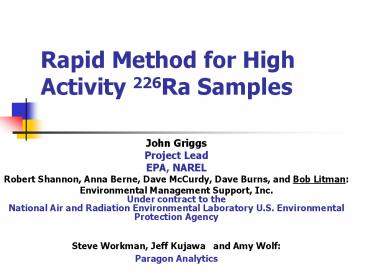Rapid Method for High Activity 226Ra Samples PowerPoint PPT Presentation
1 / 27
Title: Rapid Method for High Activity 226Ra Samples
1
Rapid Method for High Activity 226Ra Samples
- John Griggs
- Project Lead
- EPA, NAREL
- Robert Shannon, Anna Berne, Dave McCurdy, Dave
Burns, and Bob Litman - Environmental Management Support, Inc.
- Under contract to the
- National Air and Radiation Environmental
Laboratory U.S. Environmental Protection Agency - Steve Workman, Jeff Kujawa and Amy Wolf
- Paragon Analytics
2
Disclaimer
- Do not represent the U.S. EPA or NAREL
- Mention of trade names or specific applications
does not imply endorsement by EPA or EMS - Information presented is based on preliminary
reports not yet accepted by EPA
3
Existing Methods for 226Ra
- Advantages
- Well established
- Required detection levels can be achieved
- Disadvantages
- Time consuming and Technique dependent
- Approved Methods for water
- De-emanation technique no yield correction
- Precipitation method no exact yield correction
- Turn-around-time is s²?eral days to a week for
lowest detection limits
4
Why Develop a New Method for 226Ra?
- The potential of radiological contamination or
Radiological Dispersal Devices (RDDs) being
employed against the civilian population is real. - Rapid radiochemical methods are needed to support
turn around times of hours to lt 2 days
5
The New Method
- Uses the radium tracer, 225Ra
- This provides a chemically equivalent material
greater confidence in yield value - Turn-around-time is on the order of 38 hours
- Uses alpha spectrometry of 217At for final yield
determination
6
229Th as 225Ra Source
7
Ingrowth of 225Ra
8
Ingrowth of 225Ac
9
Overview of Method
10
MnO2 Batch Technique
- Effectively separates the radium from other
contaminants - Ca, Mg, Transition series elements
- some radionuclides and progeny
- Is easily achieved with no operator action
- Concentrates the radium onto a small volume of
resin - stripped with small liquid volume
11
Diphonix Column Separation
- Diphonix is Selective for
- The 229Th parent
- The 225Ac progeny
- Any other alpha emitters that may be present
- Non-Selective for
- Radium (it passes through the column during
loading)
12
Refinements to the BaSO4 Carrier Purification
- BaSO4 used as radium micro co-precipitating agent
- Final precipitate mass is 0.09 mg
- Low relative super-saturation using ammonium
sulfate - Small, dry crystals aided by precipitation from
25 (v/v ) isopropanol solution
13
Typical Alpha Spectrum
14
Spectrum of Blank
15
Alpha Spectral Resolution
16
Timeline for Sample Preparation and Analysis
17
How was the Method Validated?
- Guidance on how to perform method validation is
provided in - Method Validation Requirements for Qualifying
Methods Used by Radioanalytical Laboratories
Participating in Incident Response Activities,
EPA (in press).
18
How was the Method Validated?
- MARLAP Validation Level E was selected
- This is a new method, a Method Validation
Reference Material (MVRM) is needed. - Seven MVRM samples at each of three
concentrations are used - At ½ the Analytical Action Level
- At the Analytical Action Level
- At three times the Analytical Action Level
- Critical Net Concentration test was performed
- MDC evaluation performed at 1.0 pCi/L
19
Method Validation Decisions
- The required method uncertainty, uMR, at the AAL
is 0.65 pCi/L based on following parameters - Analytical Action Level (AAL) 5.0 pCi/L
- Discrimination Level (DL) 2.5 pCi/L
- Tolerable Error Rate for z1-a 0.01 and z1-ß
0.05 - The Required Relative Method Uncertainty, fMR,
for the method was calculated as 13 above 5
pCi/L
See Chapter 3 of MARLAP for more detail on uMR
and fMR and DQOs/MQOs.
20
Preparation of the MVRM Samples
- 226Ra test solutions were made in Atlanta, GA
drinking water (uncertainty coverage factor of k
2) - 2.52 0.84 pCi/L,
- 5.05 0.17 pCi/L and
- 15.1 0.5 pCi/L
- MDC test solution at 1.01 0.03 pCi/L
- Aliquants of these test samples were analyzed by
gamma spectrometry (after preparation) to confirm
test concentrations - Atlanta, GA drinking water was independently
analyzed for naturally occurring concentration of
226Ra
21
Acceptance Criteria and Tests
- For the MVRM samples, all analyses had to be
within the value of - 3.0uMR (at or below 5 pCi/L)
- 3.0fMR (above 5 pCi/L)
- Each concentration level was tested for bias
- Blank results were tested for bias
- An MDC test was performed, and tested for bias
22
Critical Level and Absolute Bias
23
MDC Evaluation
24
MVRM Evaluation at Low Level
25
MVRM Evaluation at AAL
26
MVRM Evaluation at Upper Level
27
Conclusion
- The use of a radium specific tracer has been
successfully employed for 226Ra analysis - Analysis times are greatly reduced
- Alpha spectrometry can resolve the other alpha
peaks - A technique for BaSO4 precipitation has been
shown to be effective for alpha spectrometry - All MQOs were achieved

